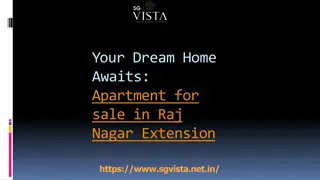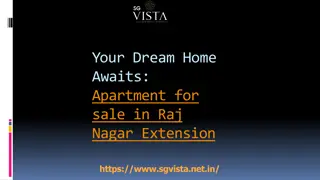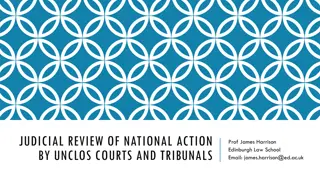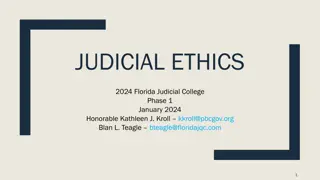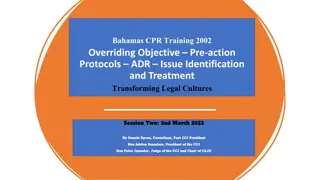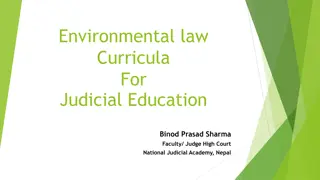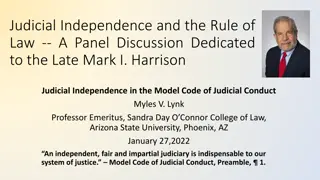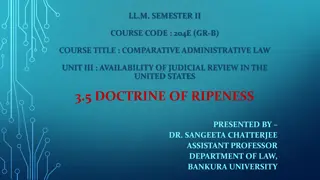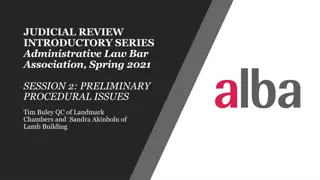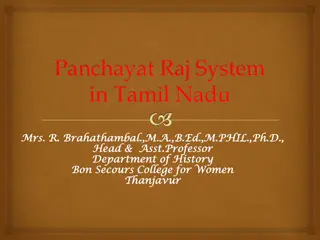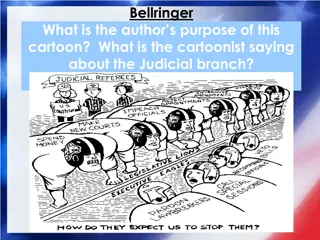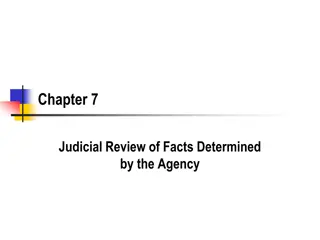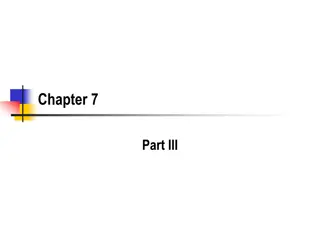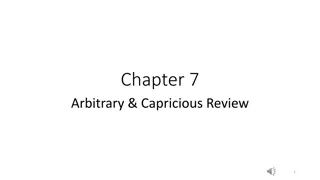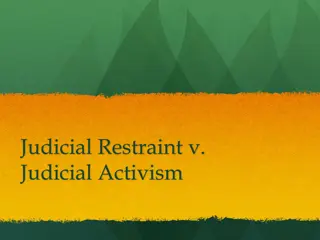
Judicial Review in India
Discover the concept of judicial review in India, its origins, and emergence in the Indian constitutional system. Learn how the judiciary interprets laws to protect fundamental rights and maintain a balance of federalism. Explore the significance of Article 13 of the Indian Constitution in dealing with judicial review.
Download Presentation

Please find below an Image/Link to download the presentation.
The content on the website is provided AS IS for your information and personal use only. It may not be sold, licensed, or shared on other websites without obtaining consent from the author. If you encounter any issues during the download, it is possible that the publisher has removed the file from their server.
You are allowed to download the files provided on this website for personal or commercial use, subject to the condition that they are used lawfully. All files are the property of their respective owners.
The content on the website is provided AS IS for your information and personal use only. It may not be sold, licensed, or shared on other websites without obtaining consent from the author.
E N D
Presentation Transcript
Judicial review KRISHNENDU RAJ AILF BOARD GROUP 1
INTRODUCTION The Constitution of India is the supreme law of the land. The Supreme Court of India has the supreme responsibility of interpreting and protecting it. It also acts as the guardian-protector of the Fundamental Rights of the people. For this purpose, the Supreme Court exercises the power of determining the constitutional validity of all laws. It has the power to reject any law or any of its part which is found to be un- constitutional. This power of the Supreme Court is called the Judicial Review power. State High Courts also exercise this power but their judgments can be rejected or modified or upheld by the Supreme Court.
JUDICIAL REVIEW Judicial Review refers the power of the judiciary to interpret the constitution and to declare any such law or order of the legislature and executive void, if it finds them in conflict with the Constitution of India.
ORIGIN The doctrine of judicial review is one of the invaluable contributions of the U.S.A. . Its origin has been the result of a judicial decision and its continuance has been possible due to some conventions. The concept of judicial review was developed by Chief Justice Marshall of the American Supreme Court in the famous Marbury v. Madison case (1803). In this case Chief Justice Marshall laid down that the judiciary has the power to examine the laws made by the legislature. It was also declared that if any such law is found to be in violation of the constitution, then such a law would be declared by the court as ultra-vires of the constitution.
EMERGENCE OF JUDICIAL REVIEW IN INDIA Indian constitution is the blend of American and British Constitutions. Indian Parliament is not a sovereign law making body like its English counterpart. It is owing to this reason that our constitutional system wonderfully adopt the via media between the American system of judicial supremacy and the English principles of parliamentary supremacy . Judicial Review is one of the cardinal features of Indian constitutional system. India has constitutional and limited democracy which imposes limitations on the power of the government and banks on majority rule to avoid tyranny and arbitrariness. The Constitution makers of India very wisely incorporated in the Constitution itself, the provisions of Judicial Review so as to maintain the balance of federalism, to protect the fundamental rights guaranteed to the citizens and to afford a useful weapon for equality, liberty and freedom.
Article dealing with Judicial Review Article 13 of the Indian Constitution Laws inconsistent with or in derogation of the fundamental rights (1) All laws in force in the territory of India immediately before the commencement of this Constitution, in so far as they are inconsistent with the provisions of this Part, shall, to the extent of such inconsistency, be void (2) (2) The State shall not make any law which takes away or abridges the rights conferred by this Part and any law made in contravention of this clause shall, to the extent of the contravention, be void (3) (3) In this article, unless the context otherwise requires law includes any Ordinance, order, bye law, rule, regulation, notification, custom or usages having in the territory of India the force of law; laws in force includes laws passed or made by Legislature or other competent authority in the territory of India before the commencement of this Constitution and not previously repealed, notwithstanding that any such law or any part thereof may not be then in operation either at all or in particular areas (4) (4) Nothing in this article shall apply to any amendment of this Constitution made under Article 368 Right of Equality
The fundamental subject of Judicial Review in the constitution of India are related to : Violation of fundamental rights Violation of various other constitutional restrictions embodied in the constitution. Enactment of legislative act in violation of constitutional mandates regarding distribution of powers. Delegation of essential legislative power by the legislature to the executive or any other body. Violation of implied limitations and restrictions. State and local laws.
Features of Judicial Review in India: Judicial Review Power is used by both the Supreme Court and High Courts. Judicial Review of both Central and State Laws. (Judicial Review cannot be conducted in respect of the laws incorporated in the 9th Schedule of the Constitution) Judicial Review applies only to the questions of law. It cannot be exercised in respect of political issues. Judicial Review is not automatic: The Supreme Court does not use the power of judicial review of its own. It can use it only when any law or rule is specifically challenged before it or when during the course of hearing a case the validity of any law is challenged before it.
Judicial Review Decision gets implemented from the date of Judgement. Judicial Review in India is governed by the principle: Procedure Established by Law . While declaring a law unconstitutional, the Supreme Court has to cite the provisions of the constitution which it violates.
Limitations of Judicial Review There are some limitations on the judiciary on exercising its power of judicial review. It is only permissible to the extent of finding if the procedure in reaching the decision has been correctly followed but not the decision itself. It is designated only to the higher courts like the Supreme Court and the High Courts. The judiciary cannot interfere in political questions and policy matters unless absolutely necessary.
Judicial Review and Constitution According to Article 13(2), the Union or the States shall not make any law that takes away or abridges any of the fundamental rights, and any law made in contravention of the aforementioned mandate shall, to the extent of the contravention, be void. Judicial review is called upon to ensure and protect Fundamental Rights which are guaranteed in Part III of the Constitution. The power of the Supreme Court of India to enforce these Rights is derived from Article 32 of the Constitution. This provides citizens the right to directly approach the SC to seek remedies against the violation of Fundamental Rights.
Judicial Review Classification Judicial review of legislative action Judicial review for judicial decision Judicial review of administrative action These facets of judicial review were pronounced by the S.C.I. in case of L.Chandra Kumar v. Union of India AIR 1997 SC 1125 stating that the judges of higher court have to interpret legislation up to this end that the Constitutional values are not to be interrupted. To achieve this end, the judges have to keep in mind that the legislature passed the law, which is in harmony by way of establishment of the Indian Constitution. The powers to review legislation are vested by way of the S.C.I. and state s higher courts, for the resolution of judicial assessment. The judicial assessment of legislation is in conformism, through the establishment of the Constitution.
EXAMPLES OF JUDICIAL REVIEW IT Act Section 66(A) In 2015, the SC struck down Section 66(A) of the amended Information Technology Act, 2000. This provided the punishment for sending offensive messages through a computer or any other communication device like a mobile phone or a tablet. A conviction could fetch a maximum of three years in jail and a fine. This was repealed by the SC on the grounds that this section fell outside Article 19(2) of the Constitution, which relates to freedom of speech. Golaknath Case (1967) The questions, in this case, were whether amendment is a law; and whether Fundamental Rights can be amended or not. SC contented that Fundamental Rights are not amenable to the Parliamentary restriction as stated in Article 13, and that to amend the Fundamental rights a new Constituent Assembly would be required. Also stated that Article 368 gives the procedure to amend the Constitution but does not confer on Parliament the power to amend the Constitution.
CONCLUSION The growth of judicial review is the inevitable response of the judiciary to ensure proper check on the exercise of public power. Growing awareness of the rights in the people; the trend of judicial scrutiny of every significant governmental action and the readiness even of the executive to seek judicial determination of debatable or controversial issues, at times, may be, to avoid its accountability for the decision, have all resulted in the increasing significance of the role of the judiciary. There is a general perception that the judiciary in this country has been active in expansion of the field of judicial review into non-traditional areas, which earlier were considered beyond judicial purview.



